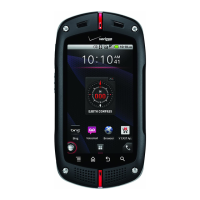109
Connecting to devices
Connecting to Bluetooth
®
devices
Bluetooth is a short-range wireless communications technology that
devices can use to exchange information over a distance of about
8 meters. The most common Bluetooth devices are headphones for
placing calls or listening to music, hands-free kits for cars, and other
portable devices, including laptops and cell phones.
To connect to a Bluetooth device, you must turn on your phone’s
Bluetooth radio. The first time you use a new device with your phone,
you must “pair” them, so that they know how to connect securely to
each other. After that, you can simply connect to a paired device.
The Status bar displays icons that indicate Bluetooth status.
Bluetooth is on
Connected to a Bluetooth device
NOTES
There are several Bluetooth profiles that define the features and •
communications standards for Bluetooth devices. Your phone
supports the Bluetooth profiles: HSP, HFP, A2DP, AVRCP, OBEX,
OPP, PBAP, GAVDP, AVDTP, and AVCTP.
OPP (Object Push Profile) allows you to send and receive the •
following types of files between Bluetooth devices: Contacts
(vCard), image (JPEG, Bitmap, PNG, WinBMP, GIF), and movie
(3G2, 3GP, MP4). Movie (WMV) and music (MP3, M4A) files can
only be received.
Turning Bluetooth on or off
1. On the Home screen, touch the Menu key M > Settings >
Wireless & networks.
2. Check or uncheck Bluetooth to turn it on or off.

